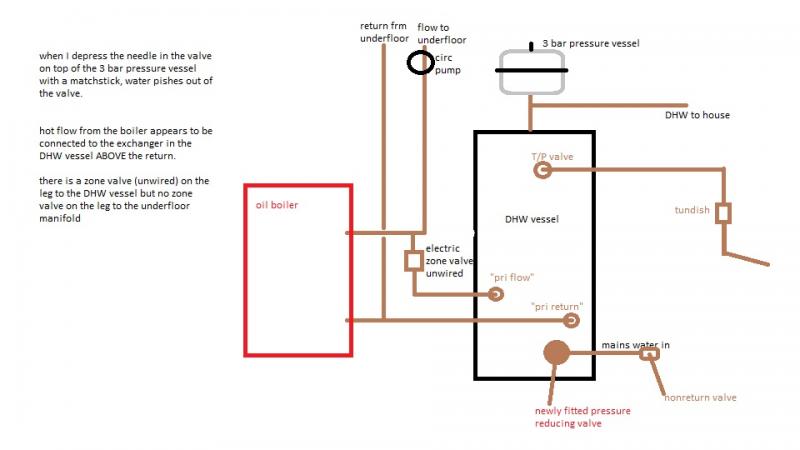- Joined
- 24 Nov 2004
- Messages
- 428
- Reaction score
- 4
- Country

was just at a neighbour's to investigate a chronic problem (newly renovated old farmhouse, single mum, not much common sense... and she didnt have much of a clue either)
her tundish had been running water for ages & ages, and massive electric bills in cold weather caused her to take an interest.
this is as much as I could work out:
I noticed there was no pressure reducing valve on the cold inlet to the DHW cylinder so found the one that had come with the cylinder and fitted it immediately. this *appears* to have solved the problem of the T/P blowoff valve constantly letting plenty water run thru the tundish.
however water was still dripping in the tundish.
I then located the valve on the pressure vessel expansion tank, and whilst checking the pressure there, noticed that water (rather than air) was squirting out of the valve if I depressed it.
call me old fashioned but isnt this indicating a shagged pressure vessel?
next q, I noticed the pri flow is going into the DHW cyl ABOVE the pri return.
I always thought that hot water went IN the bottom and OUT the top...???
next q, there appears to be 1 TRV on the pri flow, but no TRV on the flow to the UFH. shouldnt there be one on each?
there is absolutely no remote control to the system, looks like a half done job.
the professionals have been called, but its a 2 week wait (offshore island). just wanted to get her going with hot water. the situation is not exactly dangerous, as its oil fired, and the plant is in a leanto outbuilding.
she doesnt have an electric shower either so is having to traipse across fields for a shower at the neighbours.[/img]
her tundish had been running water for ages & ages, and massive electric bills in cold weather caused her to take an interest.
this is as much as I could work out:
I noticed there was no pressure reducing valve on the cold inlet to the DHW cylinder so found the one that had come with the cylinder and fitted it immediately. this *appears* to have solved the problem of the T/P blowoff valve constantly letting plenty water run thru the tundish.
however water was still dripping in the tundish.
I then located the valve on the pressure vessel expansion tank, and whilst checking the pressure there, noticed that water (rather than air) was squirting out of the valve if I depressed it.
call me old fashioned but isnt this indicating a shagged pressure vessel?
next q, I noticed the pri flow is going into the DHW cyl ABOVE the pri return.
I always thought that hot water went IN the bottom and OUT the top...???
next q, there appears to be 1 TRV on the pri flow, but no TRV on the flow to the UFH. shouldnt there be one on each?
there is absolutely no remote control to the system, looks like a half done job.
the professionals have been called, but its a 2 week wait (offshore island). just wanted to get her going with hot water. the situation is not exactly dangerous, as its oil fired, and the plant is in a leanto outbuilding.
she doesnt have an electric shower either so is having to traipse across fields for a shower at the neighbours.[/img]

